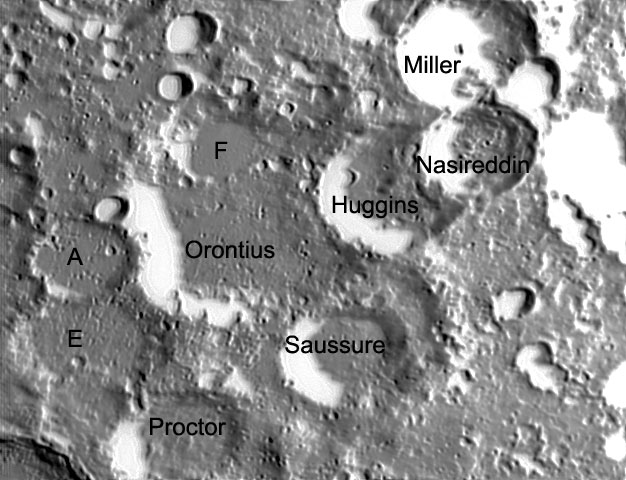|
 (English version,
Wikipedia copyright)
(English version,
Wikipedia copyright)
Orontius
is a lunar impact crater that lies in the heavily-cratered southern
highlands of the Moon's near side. It is located to the northwest of the
prominent Tycho crater, and south and east of the large Deslandres
walled-plain. The eastern part of the crater is overlaid by the smaller
Huggins crater, which is overlain in turn on its eastern rim by the still
smaller Nasireddin crater, the trio forming a crater chain of diminishing
dimensions. Joined to the southern rim is the Saussure crater. To the
southwest, just east of Tycho, is the Pictet crater.
The rim of Orontius is battered, worn, and overlain by a number of different
craters. A pair of craters to the wes have intruded into the crater wall,
forming inward bulges. Little of the original wall remains nearly intact,
with the south and southwestern rim having survived the erosion process
better than the other wall sections.
The southwest half of the crater floor is still fairly flat and marred only
by a few small craterlets. In the north of the crater, the distorted feature
'Orontius F' forms a distorted, crater-like oval.
|
 Orontius
est une plaine close de 122 Km situé sur le plateau continental dans un
enchevêtrement de cratères. La partie orientale du cratère est couverte par
le cratère plus petit Huggins (65 Km). Ce dernier est lui même recouvert sur
son mur oriental par le cratère encore plus petit Nasireddin (53 Km). Le
trio formant une chaîne de cratère de dimensions décroissante. Joint au mur
méridional on trouve le cratère Saussure (54 Km, 1880 m) recouvrant un
ancien cratère de taille supérieure. La muraille d'Orontius est impactée,
érodée, et recouverte par un certain nombre de différents cratères. Une
paire de cratères a l’ouest Orontius A et E se sont imposées dans le mur du
cratère, formant des bombements vers l’intérieur. Peu du mur original reste
presque intact. C’est le mur Sud qui a survécu le mieux au procédé
d'érosion. La moitié Sud-ouest du plancher est assez plate et troublée
seulement par quelques petits craterlets. Dans le nord du cratère, le
cratère Orontius F a rempli cette partie du plancher.
Orontius
est une plaine close de 122 Km situé sur le plateau continental dans un
enchevêtrement de cratères. La partie orientale du cratère est couverte par
le cratère plus petit Huggins (65 Km). Ce dernier est lui même recouvert sur
son mur oriental par le cratère encore plus petit Nasireddin (53 Km). Le
trio formant une chaîne de cratère de dimensions décroissante. Joint au mur
méridional on trouve le cratère Saussure (54 Km, 1880 m) recouvrant un
ancien cratère de taille supérieure. La muraille d'Orontius est impactée,
érodée, et recouverte par un certain nombre de différents cratères. Une
paire de cratères a l’ouest Orontius A et E se sont imposées dans le mur du
cratère, formant des bombements vers l’intérieur. Peu du mur original reste
presque intact. C’est le mur Sud qui a survécu le mieux au procédé
d'érosion. La moitié Sud-ouest du plancher est assez plate et troublée
seulement par quelques petits craterlets. Dans le nord du cratère, le
cratère Orontius F a rempli cette partie du plancher.
|

|
|



 Orontius
Orontius